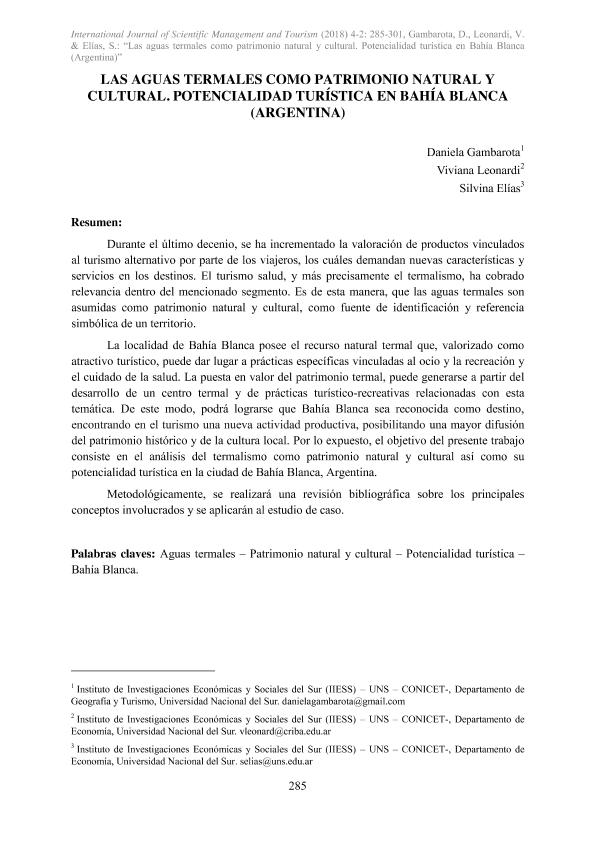Mostrar el registro sencillo del ítem
dc.contributor.author
Gambarota, Daniela Melisa

dc.contributor.author
Leonardi, Viviana Silvia

dc.contributor.author
Elías, Silvina Renée

dc.date.available
2019-12-04T13:00:58Z
dc.date.issued
2018-05
dc.identifier.citation
Gambarota, Daniela Melisa; Leonardi, Viviana Silvia; Elías, Silvina Renée; Las aguas termales como patrimonio natural y cultural. Potencialidad turística en Bahía Blanca (Argentina); iManagement and Tourism; International Journal of Scientific Management and Tourism; 4; 2; 5-2018; 285-301
dc.identifier.issn
2444-0299
dc.identifier.uri
http://hdl.handle.net/11336/91316
dc.description.abstract
Durante el último decenio, se ha incrementado la valoración de productos vinculados al turismo alternativo por parte de los viajeros, los cuáles demandan nuevas características y servicios en los destinos. El turismo salud, y más precisamente el termalismo, ha cobrado relevancia dentro del mencionado segmento. Es de esta manera, que las aguas termales son asumidas como patrimonio natural y cultural, como fuente de identificación y referencia simbólica de un territorio.La localidad de Bahía Blanca posee el recurso natural termal que, valorizado como atractivo turístico, puede dar lugar a prácticas específicas vinculadas al ocio y la recreación y el cuidado de la salud. La puesta en valor del patrimonio termal, puede generarse a partir del desarrollo de un centro termal y de prácticas turístico-recreativas relacionadas con esta temática. De este modo, podrá lograrse que Bahía Blanca sea reconocida como destino, encontrando en el turismo una nueva actividad productiva, posibilitando una mayor difusión del patrimonio histórico y de la cultura local. Por lo expuesto, el objetivo del presente trabajo consiste en el análisis del termalismo como patrimonio natural y cultural así como su potencialidad turística en la ciudad de Bahía Blanca, Argentina. Metodológicamente, se realizará una revisión bibliográfica sobre los principales conceptos involucrados y se aplicarán al estudio de caso.
dc.description.abstract
During the last decade, there has been increased the valuation of products linked to the alternative tourism on the part of the travelers, which demand new characteristics and services in the destinations. The tourism health, and more precisely the termalismo, they have received relevancy inside the mentioned segment. It is hereby, that the thermal waters are assumed as natural and cultural heritage as source of identification and symbolic reference of a territory.The locality of Bahía Blanca possesses the natural thermal resource that, valued as tourist attraction, can give place to specificpracticeslinked to theleisure and therecreation and thecare of thehealth. The putting in value of the thermal heritage, can be generated from the development of a thermal center and of tourist - recreative practices related to this subject matter. Thus, it will be able to achieve that Bahía Blanca is recognized as destination, finding in the tourism a new productive activity, making possible a major diffusion of the historical heritage and of the local culture. For the exposed thing, the aim of the present work consists of the analysis of the termalismo as natural and cultural heritage as well as his tourist potential.Methodologically, a bibliographical review will be realized on the principal involved concepts and they will be applied to the study of case.
dc.format
application/pdf
dc.language.iso
spa
dc.publisher
iManagement and Tourism
dc.rights
info:eu-repo/semantics/openAccess
dc.rights.uri
https://creativecommons.org/licenses/by-nc/2.5/ar/
dc.subject
AGUAS TERMALES
dc.subject
PATRIMONIO NATURAL Y CULTURAL
dc.subject
POTENCIALIDAD TURÍSTICA
dc.subject
BAHÍA BLANCA
dc.subject.classification
Otras Humanidades

dc.subject.classification
Otras Humanidades

dc.subject.classification
HUMANIDADES

dc.title
Las aguas termales como patrimonio natural y cultural. Potencialidad turística en Bahía Blanca (Argentina)
dc.title
The thermal waters like natural heritage and cutural. Tourist potential in Bahia Blanca (Argentine)
dc.type
info:eu-repo/semantics/article
dc.type
info:ar-repo/semantics/artículo
dc.type
info:eu-repo/semantics/publishedVersion
dc.date.updated
2019-10-17T14:21:51Z
dc.identifier.eissn
2386-8570
dc.journal.volume
4
dc.journal.number
2
dc.journal.pagination
285-301
dc.journal.pais
España

dc.journal.ciudad
Córdoba
dc.description.fil
Fil: Gambarota, Daniela Melisa. Universidad Nacional del Sur. Departamento de Geografía y Turismo; Argentina. Consejo Nacional de Investigaciones Científicas y Técnicas. Centro Científico Tecnológico Conicet - Bahía Blanca. Instituto de Investigaciones Económicas y Sociales del Sur. Universidad Nacional del Sur. Departamento de Economía. Instituto de Investigaciones Económicas y Sociales del Sur; Argentina
dc.description.fil
Fil: Leonardi, Viviana Silvia. Consejo Nacional de Investigaciones Científicas y Técnicas. Centro Científico Tecnológico Conicet - Bahía Blanca. Instituto de Investigaciones Económicas y Sociales del Sur. Universidad Nacional del Sur. Departamento de Economía. Instituto de Investigaciones Económicas y Sociales del Sur; Argentina
dc.description.fil
Fil: Elías, Silvina Renée. Consejo Nacional de Investigaciones Científicas y Técnicas. Centro Científico Tecnológico Conicet - Bahía Blanca. Instituto de Investigaciones Económicas y Sociales del Sur. Universidad Nacional del Sur. Departamento de Economía. Instituto de Investigaciones Económicas y Sociales del Sur; Argentina
dc.journal.title
International Journal of Scientific Management and Tourism
dc.relation.alternativeid
info:eu-repo/semantics/altIdentifier/url/https://dialnet.unirioja.es/servlet/articulo?codigo=6640369
dc.relation.alternativeid
info:eu-repo/semantics/altIdentifier/url/http://www.ijosmt.com/index.php/ijosmt/article/view/361
Archivos asociados
